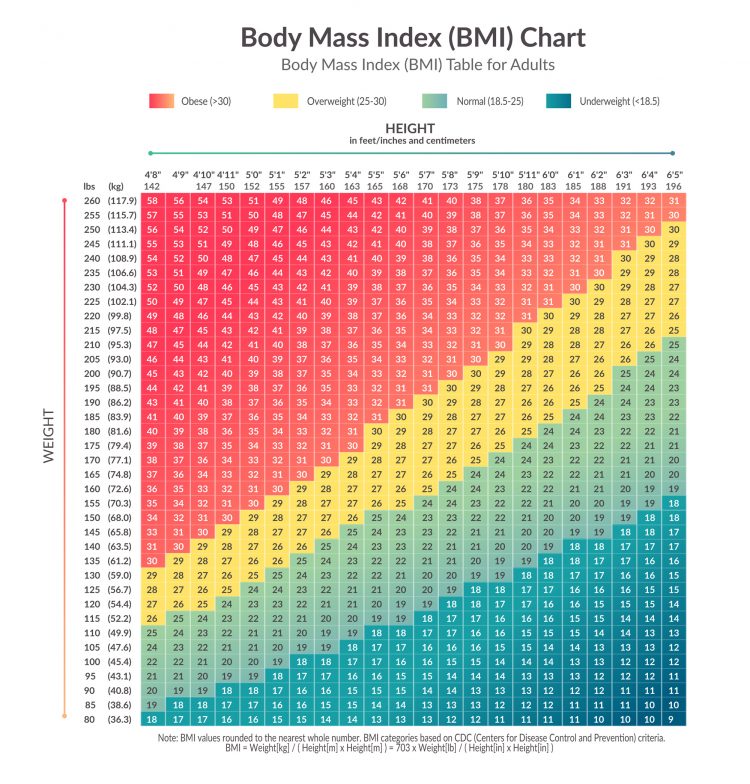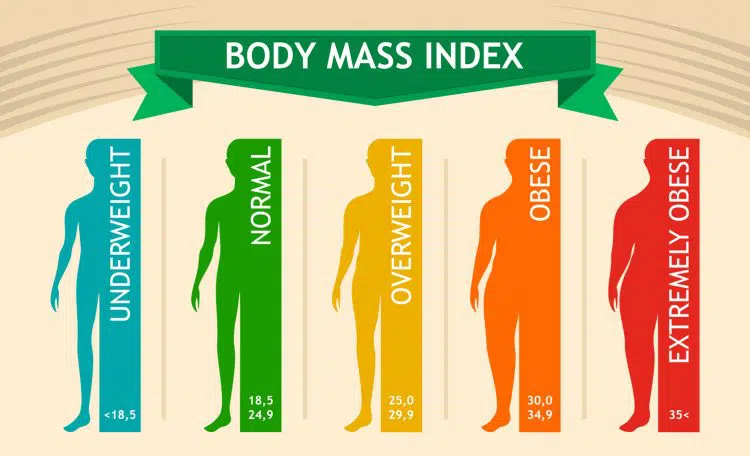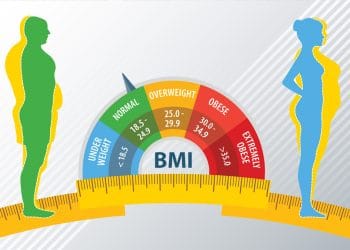The BMI (Body Mass Index) Calculator is a health-based tool that estimates body fat mass in children, teens, and adults.
What is Body Mass Index (BMI)?
Body mass index is an estimate of body fat based on an individual’s weight and height. It’s one way to determine whether or not someone is at a healthy weight.
BMI is not an accurate measure of body fat percentage. However, it uses a formula (weight in kilograms divided by the square of height in meters) for an approximation of fat mass.
BMI categories
Based on your BMI score, you will be categorized accordingly.
- Underweight = <18.5
- Normal weight = 18.5 – 24.9
- Overweight = 25 – 29.9
- Obesity = 30 – 34.9
- Extreme Obesity = BMI of 35 or greater
So, for example, according to the basic BMI calculation, someone who is 5’2″ and weighs 160 lbs is considered to be overweight. They have a high BMI score between 25 and 29.9.
Level Up Your Fitness: Join our 💪 strong community in Fitness Volt Newsletter. Get daily inspiration, expert-backed workouts, nutrition tips, the latest in strength sports, and the support you need to reach your goals. Subscribe for free!
On the other end, someone who stands at 6’2″ and weighs 140 lbs would be considered underweight or having too little fat on their body.
LBM Calculator – Find Your Lean Body Mass Calculator
BMI Chart for Adults
Following is an example of a BMI chart.

How To Use The BMI Calculator
The Body Mass Index calculator is incredibly easy and simple to use.
- Choose your unit of measurement: Imperial (lbs, feet, and inches) or Metric (kilograms, meters, and centimeters).
- Select your gender
- Enter your weight
- Type in your height
- Provide your age
Hit calculate and that’s it!
Related: Use our reverse BMI calculator to estimate the weight you need to be at to achieve a specific BMI score.
How Accurate Is The BMI Calculation?
Using BMI as a measure of whether or not someone is at a healthy weight may be a good option for many people.
However, it does not take into account variables such as body composition, body type (e.g, smaller or larger frame and bone mass), ethnicity, genetics, or how much muscle mass someone has.
For example, let’s say two people are considered overweight based on the basic BMI formula. But one has more muscle, bigger bones, and a healthy body fat percentage, while the other has a very high body fat percentage.
Do you see how BMI is not necessarily always a good indicator of healthy body weight?
For adults, only weight and height are considered. There are many different body types and variables that determine a healthy or unhealthy weight.
However, BMI calculators that recommend a weight range can be a useful tool for most people.
Try these body composition exercises to build some muscle, lose fat, and achieve a healthier weight.
Our BMI Calculator
While the BMI calculator, in its most basic form, does not provide you with a recommended or ideal body weight, but rather a BMI score, our BMI calculator does. In fact, it recommends a healthy weight range.
So, for example, if you are 40 years old, 5’9″ tall, and weigh 165 lbs, your recommended healthy weight range would be 125.3 – 169.3 lbs.
Your BMI would be 24.4 and your healthy BMI range would be 18.5 – 25.
Children, Teens, and Young Adults
The BMI calculator can also estimate body mass index in toddlers and teens as well as adults.
During childhood and early adolescence, a lot of physical growth takes place and there are more factors to consider when estimating BMI.
For example, puberty often causes kids to gain weight rather quickly as they grow and develop.
Because of this, the BMI calculator uses BMI-for-age percentile based on the CDC (Center For Disease Control and Prevention) growth charts for children and teens/young adults ages 2 to 20 years.
BMI-for-age percentile compares children’s or teens’ weight to others of the same age and sex.
To give you an example, a 14-year old female who is 5’5″ tall and weighs 117 pounds would be considered a healthy weight. She’d be in the 5%-85% range or percentile with a BMI of 19.5.
Underweight for her age and sex would be less than the fifth percentile whereas overweight is considered 85th to less than the 95th percentile and obese is equal to or greater than the 95th percentile (1).
Related: TDEE (total daily energy expenditure) Calculator
What Is Ponderal Index?
After you enter the required information into the calculator and hit calculate, you’ll also see Ponderal Index score next to your BMI score.
Ponderal Index (PI) or corpulence Index is similar to the BMI measurement in that it estimates body fat according to weight and height.
However, it’s believed to be a more specific and reliable method for determining leanness or body fat in individuals who are taller or shorter in stature. BMI seems to be a more appropriate indicator of body fat in larger populations of people who are more around average height.
Level Up Your Fitness: Join our 💪 strong community in Fitness Volt Newsletter. Get daily inspiration, expert-backed workouts, nutrition tips, the latest in strength sports, and the support you need to reach your goals. Subscribe for free!
The PI also uses a different formula than BMI. The main difference between the two is that the BMI formula squares the height whereas PI cubes the height.
For example:
The following formulas are for adults.
BMI = weight / height²
PI = weight / height³
Ponderal Index formula for infants and children = 100 x Weight (grams) / Height3 (cm)
PI scores for adults
- Underweight (8-11)
- Normal weight (11-15)
- Overweight (15-17)
- Obese >17
A PI value between 2.2 and 3 is considered normal and healthy for infants and children.
How To Achieve a Healthy Body Weight
While resistance training and exercise are incredibly beneficial for both physical and mental health, just being more active should be a priority for everyone.
That means making time to go for a brisk walk, doing something that gets your heart rate up, and not being too sedentary.
Use our heart rate calculator to find your target heart rate zone during physical activity.
According to the CDC, obesity prevalence increased by more than 10% from 1999-2000 through 2017 and 2018. During the same period, the prevalence of severe obesity more than doubled from 4.7% to 9.2%. That is significant and very alarming (2).
The side effects of obesity and severe obesity include heart disease, stroke, and various cancers which are all causes of premature death.
Due to our technology-heavy, junk food-obsessed lifestyles, it’s easier than ever to gain fat weight on a weekly basis.

Change your habits
If you find yourself sitting around too much and giving in to your cravings a little too often, that’s a sign that something needs to change. While it may not necessarily affect you in the immediate short term, bad habits are detrimental in the long term.
Use this weight loss calculator to find your ideal calorie intake to shed pounds and reach a healthier body weight.
Start slow and do a little each day until you build up to several hours of activity per week and include some weight-bearing or resistance training exercises. This is important to keep your bones and muscles strong and prevent injuries especially as you age.
The best way to get up and doing things is to do something that you enjoy but that always requires total-body movement. Whether that’s walking in a nice park, martial arts, shooting hoops, swimming, or playing an activity-based game with your family, these are all good choices.
Try these fun workout games.
Get your eating right
Having a healthy daily nutrition regime is just as important (yes, we know, easier said than done) for weight management and health.
For those who need to watch their weight, that means keeping an eye on your calorie intake and watching the scale to ensure you’re staying within a healthy weight range and not gaining weight, especially on a monthly basis.
It’s best to choose healthy foods that are not insanely calorically dense like the options you’ll grab at a drive-thru window or order at your favorite restaurant.
Also read: The Greatest Healthy Grocery List For Improving Your Health
On the other end, underweight individuals should eat more of those healthy foods throughout the day. It really helps to eat more frequently as this stimulates your hunger hormones and it’s a good habit to make time to fuel your body with the nutrients it needs to function healthily and optimally.
Set a clock to go off every 2.5 to 3 hours if you have to, to remind yourself that it’s time to put something in your belly.
Another very effective habit to make a part of your weekly routine is to prepare your meals so that you’re not tempted to skip out on eating. Having healthy snacks at the ready is also a good strategy.
Use this weight gain calculator to determine how many calories you should be eating to gain weight at a healthy pace.
Sometimes our busy lifestyles cause us to ignore meal times and while consuming fewer calories, going long hours without eating/ fasting has its benefits, people who are underweight should focus on getting to a healthy weight.
We also recommend resistance training for underweight folks as your body will use those calories to build muscle mass, a healthier and better option than gaining lots of body fat. This will also improve your body composition in the process.
Take our Body Type Quiz to determine if you’re an ectomorph, mesomorph, endomorph, or a combination.
Ectomorph Workout: The Skinny Guy’s Training Guide
It’s very important to understand that it will take some effort, being in control, and making good decisions to ensure you achieve and maintain a healthy body weight.
Find Your BMI
The BMI calculator isn’t always the most accurate method of determining healthy body weight as things like age, body composition, bone mass, and how much muscle you have are factors that vary between people.
But it’s relatively accurate and reliable for most people and even active individuals.
Use this tool as a general guideline for maintaining a healthy weight range.
Calculation Reference Links:
1. CDC (2021-06-07). “BMI Calculator for Child and Teen”. Centers for Disease Control and Prevention.
2. “BMI Calculator Child and Teen | Healthy Weight | CDC”. www.cdc.gov.
3. “Body Mass Index (BMI) (for Parents) – Nemours Kidshealth”. kidshealth.org.
4. 2 to 20 years: Boys Body mass index-for-age percentiles. www.cdc.gov.
4. 2 to 20 years: Girls Body mass index-for-age percentiles. www.cdc.gov.












